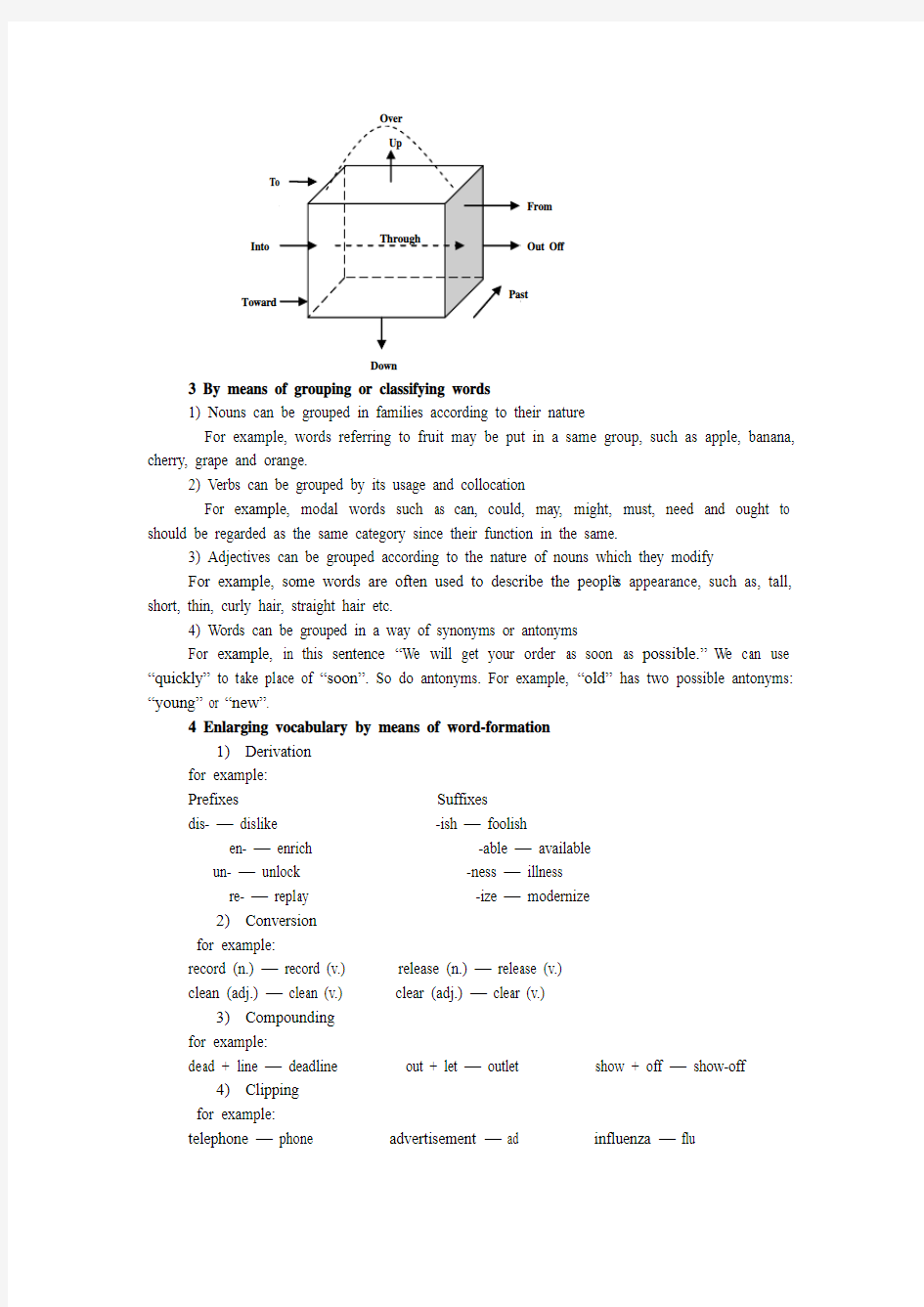Vocabulary is one of the most important components of language


Discussion on Techniques of English
V ocabulary Teaching in the Middle School
Vocabulary is one of the most important components of language. Both English teaching and learning in the middle school are the key stage. Besides, English vocabulary teaching is the basis of English teaching. The thesis aims at discussing and pursuing some techniques on English vocabulary teaching in the middle school and providing some techniques as well.
1 Teaching English vocabulary in a context
For example, a teacher makes use of the story to teach the new word “calm”. One day, two boys got excited. They quarreled with each other. It seemed that they were going to fight. At the moment, our monitor came up and calmed them. He said: “Calm down, calm down. Don’t quarrel any more.” The two boys became calm at last and stopped quarrelling. The word “c alm” in this story is used as a verb and an adjective. From the teacher’s story, students can guess the meaning of some new words.
2 Explaining the meaning of vocabulary in various ways
(1)Using the vocabulary which the students have learned
1)The teacher may use synonyms or antonyms out of a context to teach these words, for example, “fast” and “quickly” are synonyms, as for “tall” and “short” they are antonyms.
2)Teachers may also use synonyms or antonyms out of a sentence context and let students guess, for example:
a) Guessing a new word in a sentence that contains an antonym or contrary expression with the help of the word known
Lily and Lucy are twins. Lucy is outgoing, but Lily is shy.
b) Guessing a new word or a new phrase in a sentence that contains a synonym
Tom seems worried about his examination results. Jerry was also anxious about these.
3) Definitions or paraphrases
e.g. A teacher is one who teaches somebody.
(2)Using real objects to teach new words
For example, to introduce family members by means of pictures.
(3)Using facial expression and body language to help introduce words
Facial expression can be used to introduce some words relating to emotion, such as, happy, sad, and angry.
(4)Using stick figures, diagrams and maps to show the meaning of word
3 By means of grouping or classifying words
1) Nouns can be grouped in families according to their nature
For example, words referring to fruit may be put in a same group, such as apple, banana, cherry, grape and orange.
2) Verbs can be grouped by its usage and collocation
For example, modal words such as can, could, may, might, must, need and ought to should be regarded as the same category since their function in the same.
3) Adjectives can be grouped according to the nature of nouns which they modify
For example, some words are often used to describe the people ’s appearance, such as, tall, short, thin, curly hair, straight hair etc.
4) Words can be grouped in a way of synonyms or antonyms
For example, in this sentence “We will get your order as soon as possible.” We can use “quickly” to take place of “soon ”. So do antonyms. For example, “old ” has two possible antonyms: “young ” or “new ”.
4 Enlarging vocabulary by means of word-formation
1) Derivation
for example:
Prefixes Suffixes
dis- — dislike -ish — foolish
en- — enrich -able — available
un- — unlock -ness — illness
re- — replay -ize — modernize
2) Conversion
for example:
record (n.) — record (v.) release (n.) — release (v.)
clean (adj.) — clean (v.) clear (adj.) — clear (v.)
3) Compounding
for example:
dead + line — deadline out + let — outlet show + off — show-off
4) Clipping
for example:
telephone — phone advertisement — ad influenza — flu
Into Down From
Out Off
5)Blending
for example:
smog = (smoke + fog) brunch = (breakfast + lunch) workfare = (work + welfare)
6)Back-formation
for example:
beg — beggar televise — television automate — automation
5 Learning vocabulary with cultural background
For example, in the western culture, dragon is a kind of fierce and cruel monster. It is the synonym for evil, while, in Chinese culture, dragon symbolizes nobility, sacredness, might and great vitality.
6 Practising vocabulary by communication
For example, In teaching about people’s appearance. Look at the following conversation between a teacher and a student:
Teacher:I can’t find my friend, Could you help me find her?
Student:Yes. What does she look like?
Teacher: She is tall and thin, with a pair of glasses.
Student:Ok, I’ll ask more friends to help you .
Then, the student asks other students with the vocabulary and patterns.
7 Introducing some methods to memorize vocabulary
1) Association in images
for example:You can memorize “tussle” like this: “tu” and “ss” are fighting, and “ss” with a stick,that’s the alphabet “l”. In this way, students can memorize not only the word but also the meaning.
2) Association in similarity
for example:Look at this word “bird”, you can image “b” and “d” are two wings of the bird.
3) Association in sound
for example:“Click”is a short sharp sound, such as the sound of a key turning in a lock.“Bump” is the sound of something hitting something else with force.
4)Association in words with the same roots
for example:forget / forgetful / forgetfully / forgetfulness / forgettable / forgetter / unforgettable
5) Word-formation rules
According to word-formation rules in English such as, compounding, conversion and affixation
6) Synonyms and antonyms, homonyms and polysemy memory approach
7) Reading rules with letters group
